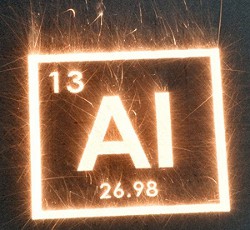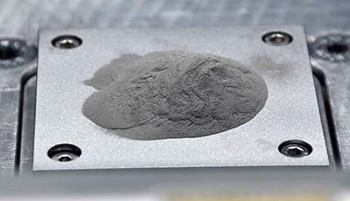 |
| October 03, 2017 | Volume 13 Issue 37 |
Designfax weekly eMagazine
Archives
Partners
Manufacturing Center
Product Spotlight
Modern Applications News
Metalworking Ideas For
Today's Job Shops
Tooling and Production
Strategies for large
metalworking plants
Engineers 3D print high-strength aluminum, solve age-old welding problem using nanoparticles

Researchers at HRL Laboratories have made a breakthrough in metallurgy by developing a technique for successfully 3D printing high-strength aluminum alloys -- including types Al7075 and Al6061. The feat opens the door to additive manufacturing of engineering-relevant alloys that are very desirable for aircraft and automobile parts.
An added benefit is that their method can be applied to additional alloy families such as high-strength steels and nickel-based superalloys, which are currently difficult to process in additive manufacturing.
"We're using a 70-year-old nucleation theory to solve a 100-year-old problem with a 21st century machine," says Hunter Martin, who co-led the team with Brennan Yahata. Both are engineers in the HRL's Sensors and Materials Laboratory and PhD students at University of California, Santa Barbara studying with Professor Tresa Pollock, a co-author on the study. Their paper, "3D printing of high-strength aluminum alloys," was published in the Sept. 21, 2017, issue of Nature. Other authors on the paper were Jacob Hundley, Justin Mayer, and Tobias A. Schaedler -- all of HRL.
Additive manufacturing using metals typically begins with alloy powders that are applied in thin layers and heated with a laser or other direct heat source to melt and solidify the layers. Normally, if high-strength unweldable aluminum alloys such as Al7075 or AL6061 are used, the resulting parts suffer severe hot cracking -- a condition that renders a metal unusable, because it can be pulled apart "like a flaky biscuit," according to the researchers.

HRL's nanoparticle "functionalization" technique solves this problem by decorating high-strength unweldable alloy powders with specially selected nanoparticles. The nanoparticle-functionalized powder is fed into a 3D printer, which layers the powder and laser-fuses each layer to construct a three-dimensional object. During melting and solidification, the nanoparticles act as nucleation sites for the desired alloy microstructure, preventing hot cracking and allowing for retention of full alloy strength in the manufactured part.
Because melting and solidification in additive manufacturing is analogous to welding, HRL's nanoparticle functionalization can also be used to make unweldable alloys weldable. This technique is also scalable and employs low-cost materials. Conventional alloy powders and nanoparticles produce printer feedstock with nanoparticles distributed uniformly on the surface of the powder grains.
VIDEO: 3D printing high-strength aluminum.
"Our first goal was figuring out how to eliminate the hot cracking altogether. We sought to control microstructure, and the solution should be something that naturally happens with the way this material solidifies," Martin says.
To find the correct nanoparticles, in this case zirconium-based nanoparticles, the HRL team enlisted Citrine Informatics to help them sort through the myriad possible particles to find the one with the properties they needed. Citrine Informatics is an operating system for advanced materials and chemicals that ingests and analyzes vast quantities of technical data on materials, chemicals, and devices to streamline R&D, manufacturing, and supply chain operations.
"Using informatics was key," says Yahata. "The way metallurgy used to be done was by farming the periodic table for alloying elements and testing mostly with trial and error. The point of using informatics software was to do a selective approach to the nucleation theory we knew to find the materials with the exact properties we needed. Once we told them what to look for, their big-data analysis narrowed the field of available materials from hundreds of thousands to a select few. We went from a haystack to a handful of possible needles."
With this exciting new technique, HRL stands at the forefront of a new chapter in additive manufacturing of metals for research, industry, and defense.
Source: HRL Laboratories
Published October 2017
Rate this article
View our terms of use and privacy policy
